Located in the Southeastern parts of the US, Alabama is one of the states with a high number of spiders.
Various species live in the state and other nearby states due to good weather and high habitat variation.
Some of the spiders in the state can be found in homes, but most aren’t dangerous to humans.
Table of Contents
Are There Venomous Spiders in Alabama?
Almost all spiders in Alabama pose a reduced threat to humans.
Some are mildly venomous while only a few species such as the Brown Recluse and the Brown Widow pose a major health risk, mainly for children and seniors.
Correctly identifying the species is mandatory when it comes to antivenin and medical attention.
Most spiders in Alabama are harmless to humans if roughly handled.
Types of Spiders in Alabama
1. Golden Silk Spider

This large spider (Trichonephila clavipes) is identified by its orange, white, yellow, and black colors. It has an elongated orange body with white multiple white dots and yellow-black legs.
The species is common both in North and South America, with Southern US states being its North American limit.
Orb-shaped spider webs are built by the species to trap all types of insects. Small flies and even bugs as grasshoppers get caught up in its spider web.
Golden Silk Spiders have no major impact on humans if they bite as their venom is weak.
Bites are rare as the spider flees when seeing humans.
2. Yellow Garden Spider

This species of black and yellow spider (Argiope aurantia) has a widespread distribution. Commonly seen around gardens as its name suggests, the species isn’t highly venomous.
Its sting is compared to a bee sting when it comes to pain levels. Red skin and swollen skin are symptoms of its bite.
Only children and the elderly may be more vulnerable to the bite of the spider.
These spiders build vertical spider webs. These webs have a reinforced central section with thicker zig-zagging silk which is known as stabilimentum.
It’s here that the female spider awaits its prey. Insects and even small geckos are commonly stuck and eaten on the spider web.
3. Spinybacked Orbweaver

These white spiders (Gasteracantha cancriformis) are a common sight across Florida’s citrus groves. It finds its habitat is also expanded to woodlands across the state.
Spinybacked Orbweaver spiders have 6 spine-like formations which are red on a base white color.
The species grows to various sizes but it remains small as even the largest Spinybacked Orbweavers only measure 13mm.
The species builds large orbital spider webs and await insects on the web itself.
People commonly encounter these spiders but their bites aren’t serious. While rare, these stings don’t require medical attention.
4. Spotted Orbweaver

This species of spider (Neoscona crucifera) is dominated by dark colors. Its appearance is based on dark brown and black color variations.
The Spotted Orbweaver is known to build very large spider webs. While many are smaller, some of these spider webs may measure as much as 2 feet in diameter, for high efficiency.
Female Spotted Orbweaver is spotted carrying egg sacs. These sacs have hundreds of eggs each.
Slower movements and the possibility of eating the eggs attract a wide range of flying predators toward the species.
Small birds are among the most common Spotted Orbweaver predators. Wasps such as mud daubers also eat the eggs of the species.
5. Twin-flagged Jumping Spider

Black and white colors are specific to this robust species of spider (Anasaitis canosa). Twin-flagged Jumping Spiders have a black body with white and gray areas along the head, thorax, and abdomen.
It doesn’t spin any spider webs as it catches prey by jumping and ambushing techniques.
Its jumping strategies depend on the prey it jumps on, which signals good vision.
These spiders align themselves with ants when jumping on them and jump on all other types of insects from any direction.
Prey cannot escape its punctures with the bite as these spiders are rather strong.
Female Twin-flagged Jumping Spiders are known to guard the eggs they lay.
6. Green Lynx Spider

These types of spiders (Peucetia viridans) are mostly green and native to North America.
The thorax is green while its abdomen is yellow with white and red marks or spots.
Yellow legs with scarce black hairs are seen in this species.
Most Green Lynx Spiders spend their lives in shrubs or around plants, as these are the places with the highest chances of catching insects.
The species jumps on insects but it can also show patience to ambush certain insects. It catches all types of flies and even wasps.
Female Green Lynx Spiders make egg sacs in one brood in Northern states and 2-3 broods in Southern states.
7. Orchard Orbweaver

These types of spiders (Leucauge venusta) are named after their common presence in orchards. Native to the US, they inhabit a wide Southeastern US habitat.
Orchard Orbweavers are spiders known to be highly common in citrus groves across Florida, where they build large spider webs.
These spider webs catch all types of insects but mosquitoes are among the preferred insects of the species, which is rather small.
An Orchard Orbweaver grows to 3-4mm.
Spiders of this genus have a dark green color with orange and black marks on the dorsal abdomen.
Reduced size and vivid coloring make it a target for predatory species. Mud dauber wasps are among its common enemies.
8. Magnolia Green Jumping Spider
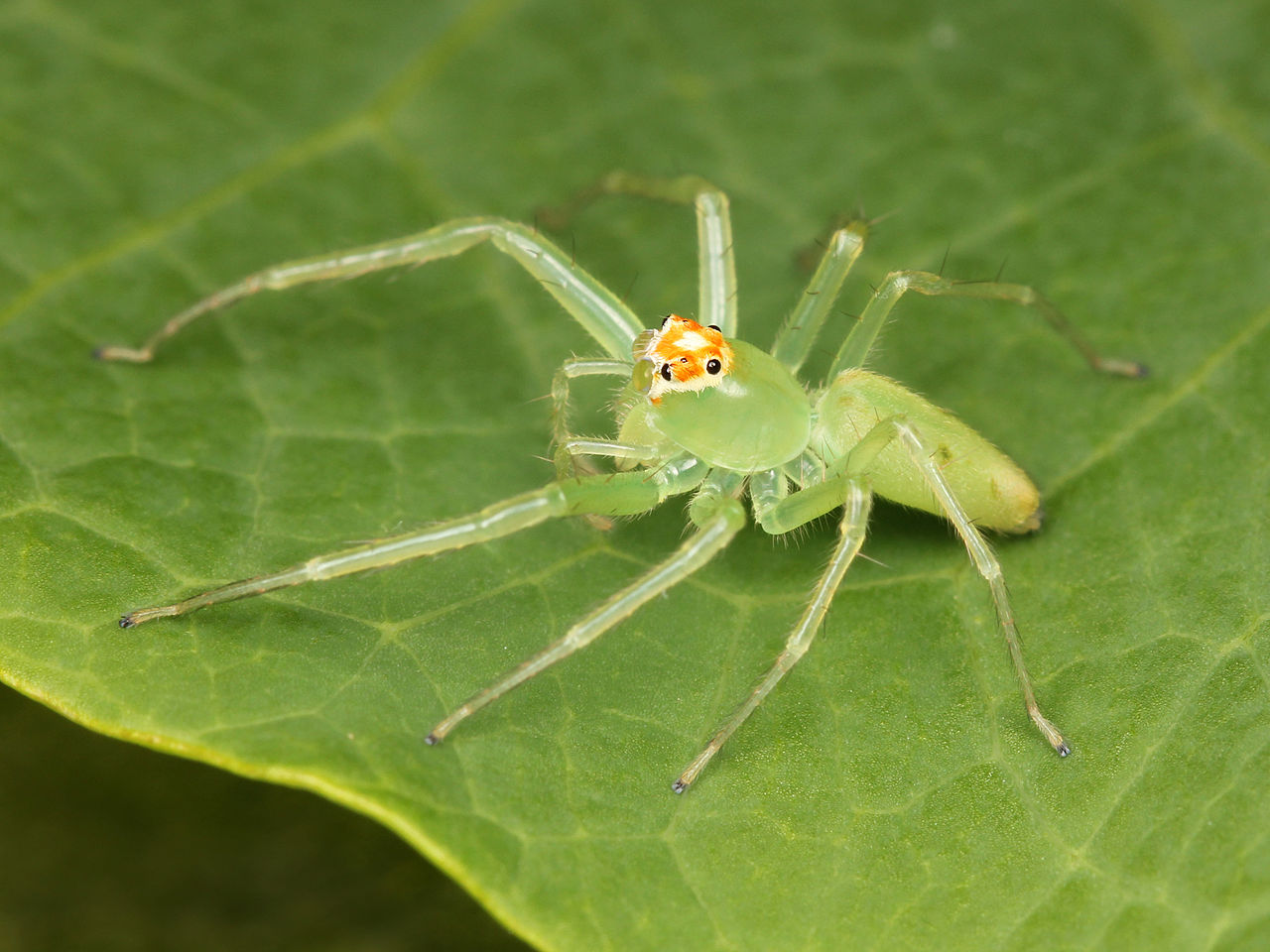
This type of spider (Lyssomanes viridis) is seen as one of the first jumping spiders of the world still seen today.
You can find it in many Southeastern states such as Georgia along with shrubs and flowers.
The species has a pale green color with 8 black spots on its abdomen.
Large black eyes surrounded by yellow circles make this species look unique.
The Magnolia Green Jumping Spider catches small insects by jumping on them. These insects are smaller than this 4-6mm spider, most times.
Spiders of this family show a high level of aggression.
Males tend to provoke each other until one of them decides to surrender and leave a certain area.
9. Tan Jumping Spider

Common in woodlands, this species (Platycryptus undatus) is native to the US and Southern territories of Canada.
It grows to an average size of 10mm and it has a base black color. Gray, white, and tan patterns are seen on the central area of its abdomen while its head and thorax are mostly gray.
These colors help it remain undetected when resting on tree bark,
Hiding under loose tree bark, the spider eats all types of small bugs and insects it finds on dead or living trees.
It uses jumping as its main predatory technique to catch its prey.
10. White-banded Fishing Spider

Native to the US, this species (Dolomedes albineus) has an expanded North American territory, far beyond the borders of Alabama.
It has a semiaquatic nature which means it spends a lot of time next to water sources. It feeds on insects that love water such as mosquitoes.
White-banded Fishing Spiders also move along to dry land considerably, compared to other semiaquatic spiders.
Green or gray nuances of the species are the most common.
Some individuals that live close to water may have a light gray color while those that travel further away take on a light green nuance to their gray color.
A base gray color allows the species to remain undetected in many environments.
11. American Nursery Web Spider
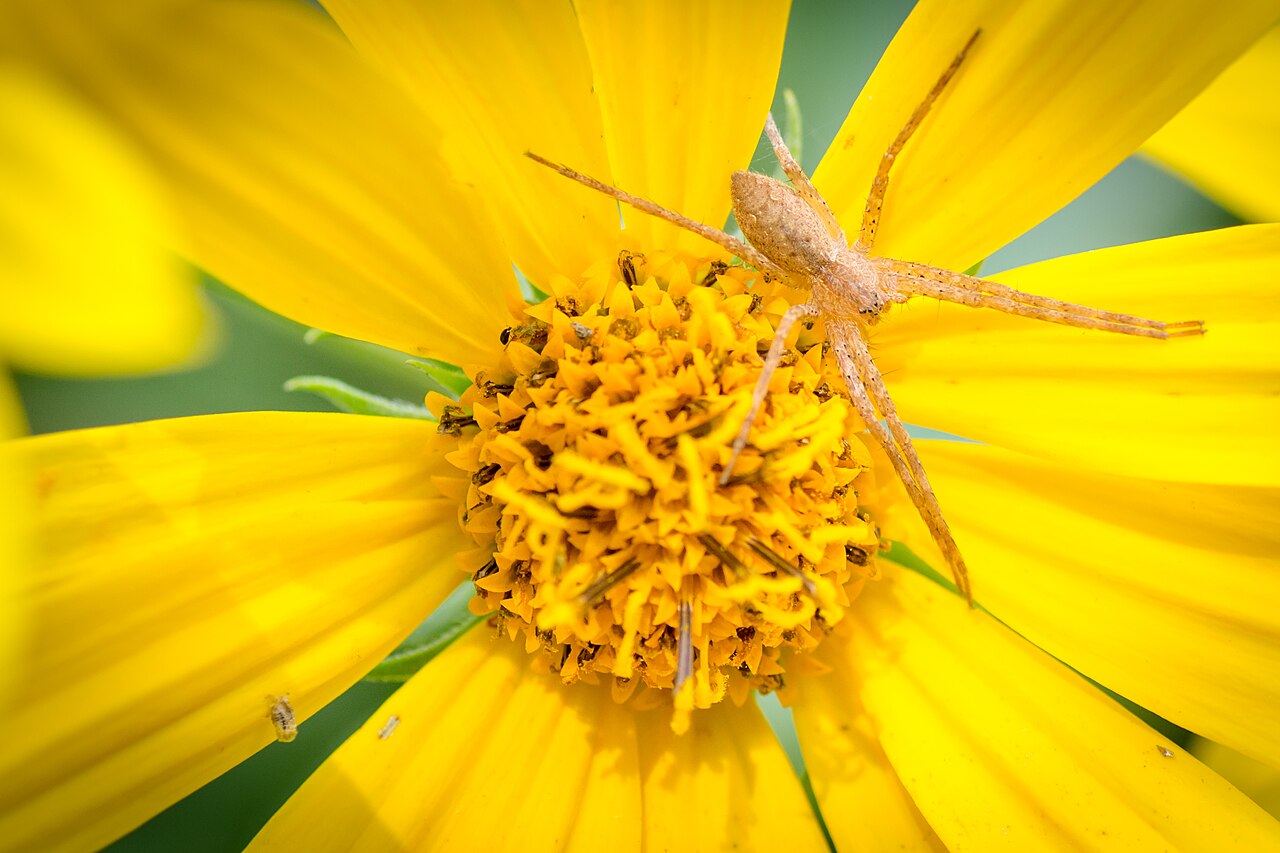
American Nursery Web Spiders (Pisaurina mira) are beneficial spiders commonly found on crops. They also live in woodlands and areas with dense vegetation.
These types of spiders have a base brown color of various nuances across their body and legs.
No spider web is built by the species as it only feeds on insects by following and jumping on them.
Gnats are among the most common foods of these spiders.
Females build small nursery webs where the eggs hatch and grow. Many types of crop bugs or bugs that feed on plants and legumes get caught up in these miniature webs.
Tarnished plant bugs are among the most common victims of the female American Nursery Web Spider.
12. Common House Spider
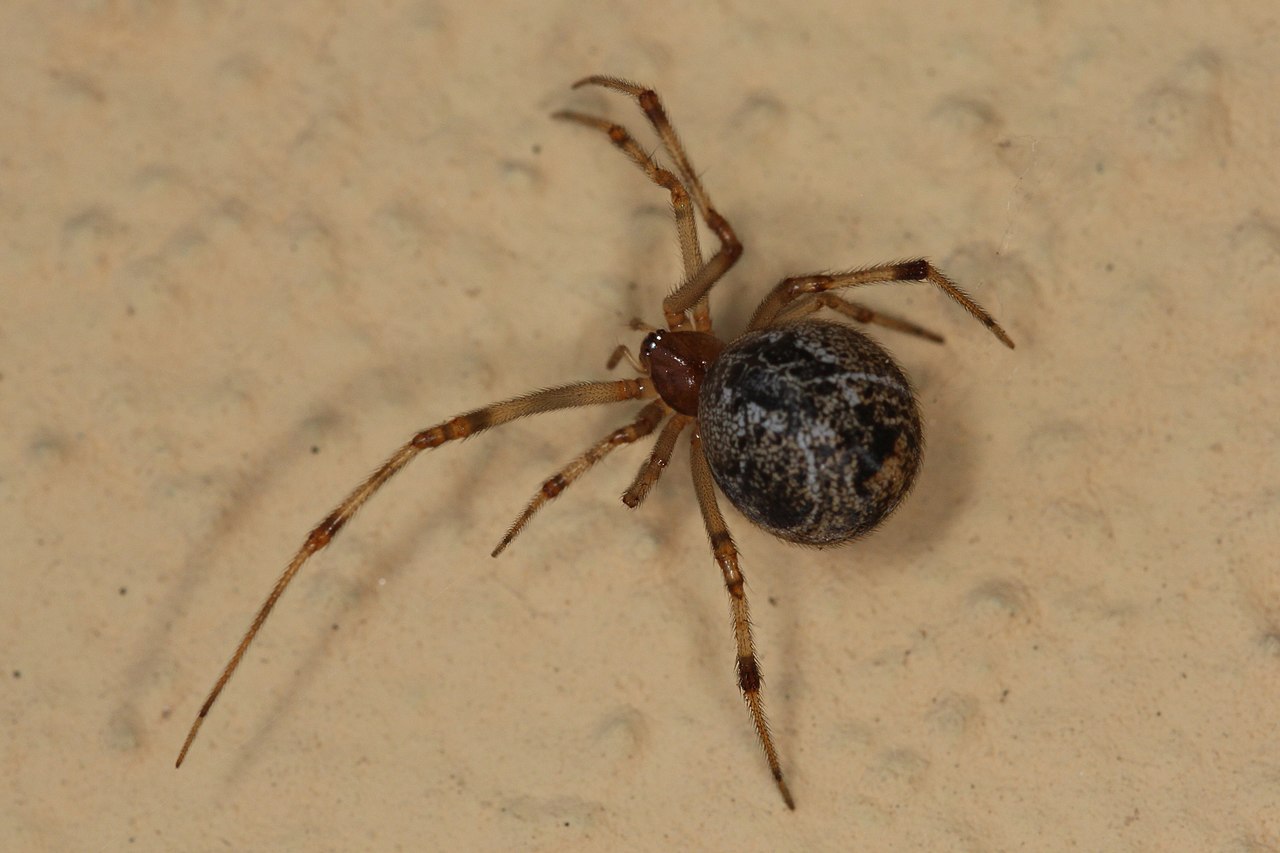
Common House Spiders (Parasteatoda tepidariorum) are among those seen in the homes of Alabama. The species can exclusively live in the house or the garage if it finds insects to feed on.
Various colors are specific to the Common House Spider. These are gray, tan, and even black colors as there’s variation in their appearance.
The species is small, rarely growing to a size larger than 5-6mm.
It feeds on small insects it finds in the house. On occasion, it also feeds on larger insects such as certain types of cockroaches.
This spider is also among the common species to show good relations to other spiders, as it may even share its spider web at times.
Assassin bugs are the largest known predators of the Common House Spider.
13. Arrowhead Orbweaver

Arrowhead Orbweavers (Verrucosa arenata) are seen everywhere around the state, including in gardens and homes.
As its name implies, the species has an arrow-shaped mark on its abdomen. This arrow shape is either white or cream while its body is mostly red or brown.
Some black spots are also distinguished on the body of the spider, but not on the arrow or triangular shape on its abdomen.
This species builds orb-shaped spider webs to catch insects.
Like most other spiders, it injects venom into trapped insects to liquefy them for easier consumption.
14. Long-bodied Cellar Spider

This species of spider (Pholcus phalangioides) is commonly found in basements, under patios and stairs, in the barn, or in the garage.
Adapted to urban living, it has a gray-brown color with long legs and the ability to build spider webs.
Long-bodied Cellar Spiders wait for prey to get caught in this spider web for a limited time.
They get off the spider web looking for insects when hungry.
Some of these spiders can even show cannibalistic traits either eating other members of their species or their eggs whenever it goes a long time without food.
Long-bodied Cellar Spiders can even eat venomous Redbacks, but they aren’t venomous to humans themselves.
15. Furrow Orbweaver
This type of spider (Larinioides cornutus) is found in moist areas or next to water around the state.
It comes in many colors ranging from shades of yellow to red or even pink.
It has a bulbous body shape with a round abdomen and a body size of up to 14mm with the smallest adult body measuring 9mm.
These spiders build spider webs for insects.
Female Furrow Orbweavers also build small silk cocoons for mating purposes.
Multiple broods are seen each year as a female may produce a few egg sacks per year.
Males often end up being cannibalized by females after mating.
16. Southern Black Widow

This spider species (Latrodectus mactans) is one of the most venomous in Alabama. While not deadly, the venom of this spider is still highly potent leading to high pain levels, swelling, and other symptoms.
Also known as The Black Widow, the species has a base black color with red marks across its abdomen.
These spiders are found anywhere around the state and they might even enter homes.
All types of small bugs and insects are the food of the species. Woodlice and chilopods are among their favorite prey.
Southern Black Widows can also eat other spiders and other arachnids.
While venomous, the species has a long list of enemies out in nature. Some of the most efficient Southern Black Widow predators include blue mud daubers.
17. Rabid Wolf Spider

Common in the state and North America, this striped spider species (Rabidosa rabida) hide in debris, under leaves, or in trash cans during the day.
It comes out to look for food in the form of various insects and arachnids when hungry.
These spiders cannot build spider webs but they have a silk-making gland. They use silk for cocoons which protect their offspring.
The Rabid Wolf Spider is a common sight around homes. Human bites are rare unless provoked.
No medical attention is needed in case of a bite.
This species is also known for complex mating rituals. Males have to make noise and perform a ritual dance in front of the female to be accepted as a mate.
18. Mabel Orchard Orbweaver

This type of orbweaver (Leucauge argyrobapta) is distinguished from the Common Orchard Orwbeaver by the silver mark on its abdomen.
Spiders of this family live in the US with an expansive habitat down to Brazil.
The species is mostly green and it builds large spider webs it relies on to catch small insects.
Diptera insects are among its most common prey. This includes species such as the common mosquito.
This spider might move to the edge of its spider web when under threat. The presence of a wasp is such an occasion.
19. Six-spotted Fishing Spider

This type of spider (Dolomedes triton) lives next to the water. It lives on various insects and even fish.
Six-spotted Fishing Spiders can eat small fish which are still larger than themselves.
The species has a hairy brown and black body with lateral white bands along its thorax and abdomen.
By a semiaquatic nature, these spiders don’t spin spider webs as they move around for prey.
The species has specific mating habits where the female tries to kill and eat males after mating. Most males manage to escape these attacks by running away.
Its venom is of no major impact on humans.
20. Marbled Orbweaver

Marbled Orbweavers (Araneus marmoreus) are common species with bulbous abdomens of various colors.
The main color of the species varies from orange to red with the abdomen color being either yellow or orange.
Further coloring differences are often noted between males and females.
The species prefers dryland to build its spider webs.
A think single silk line connects the Marbled Orbweaver with the web so that it drops to the ground in the case of a potential threat.
The species is seen in multiple colors across the state and it may even be referred to as The Pumpkin Spider.
21. Bold Jumping Spider

While sometimes black and red, the Bold Jumping Spider (Phidippus audax) isn’t as dangerous as the Black Widow.
This spider can still bite, but its bites often result in pain that lasts up to 2 days without medical complications.
This species has a base black color with either red or light blue colors.
It can be seen around homes as the Bold Jumping Spider isn’t afraid of populated areas.
Spiders of this family jump on prey directly, preferably from a higher point or a wall.
These spiders are often seen high on vegetation or on buildings where they can look out for food.
A single silk line might help them quickly and safely get on the ground whenever they see suitable insects to follow.
22. Spined Micrathena
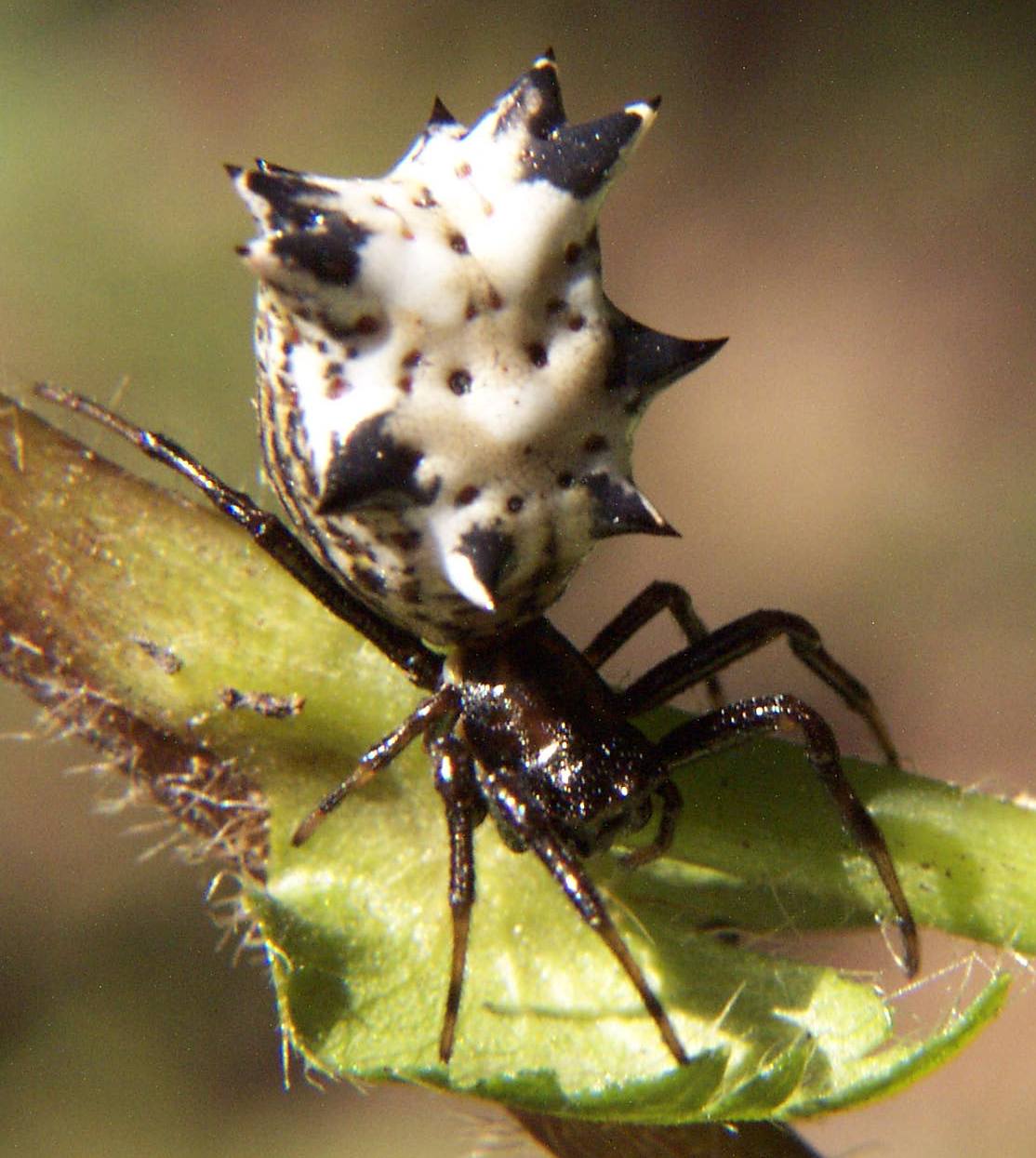
This type of spider (Micrathena gracilis) has a reduced size of up to 10mm.
White is the main color of its irregular-shaped abdomen. Black spines contrast its bright body with a spiny appearance.
Since they like moisture, these spiders are more likely to be found in parks and woodlands.
Not woodlands are suitable for Spine Micrathenas as these spiders prefer oak woodlands and hickory woodlands.
The species builds spider webs which are rebuilt or built again at night. They move web-weaving places each week.
23. Brown Widow

Brown Widows (Latrodectus geometricus) are venomous spiders that resemble Black Widows in pain levels associated with their bite.
While rare, these bites might need medical attention. Antivenin is sometimes given under medical prescription for the victims of this spider.
Brown is the main color of the species, together with red as the hourglass mark on its abdomen.
Considerable sizing differences are noted between males and larger females. Male Brown Widows grow to a size of around 4mm while females can sometimes reach 10mm.
24. Arrow-shaped Orbweaver
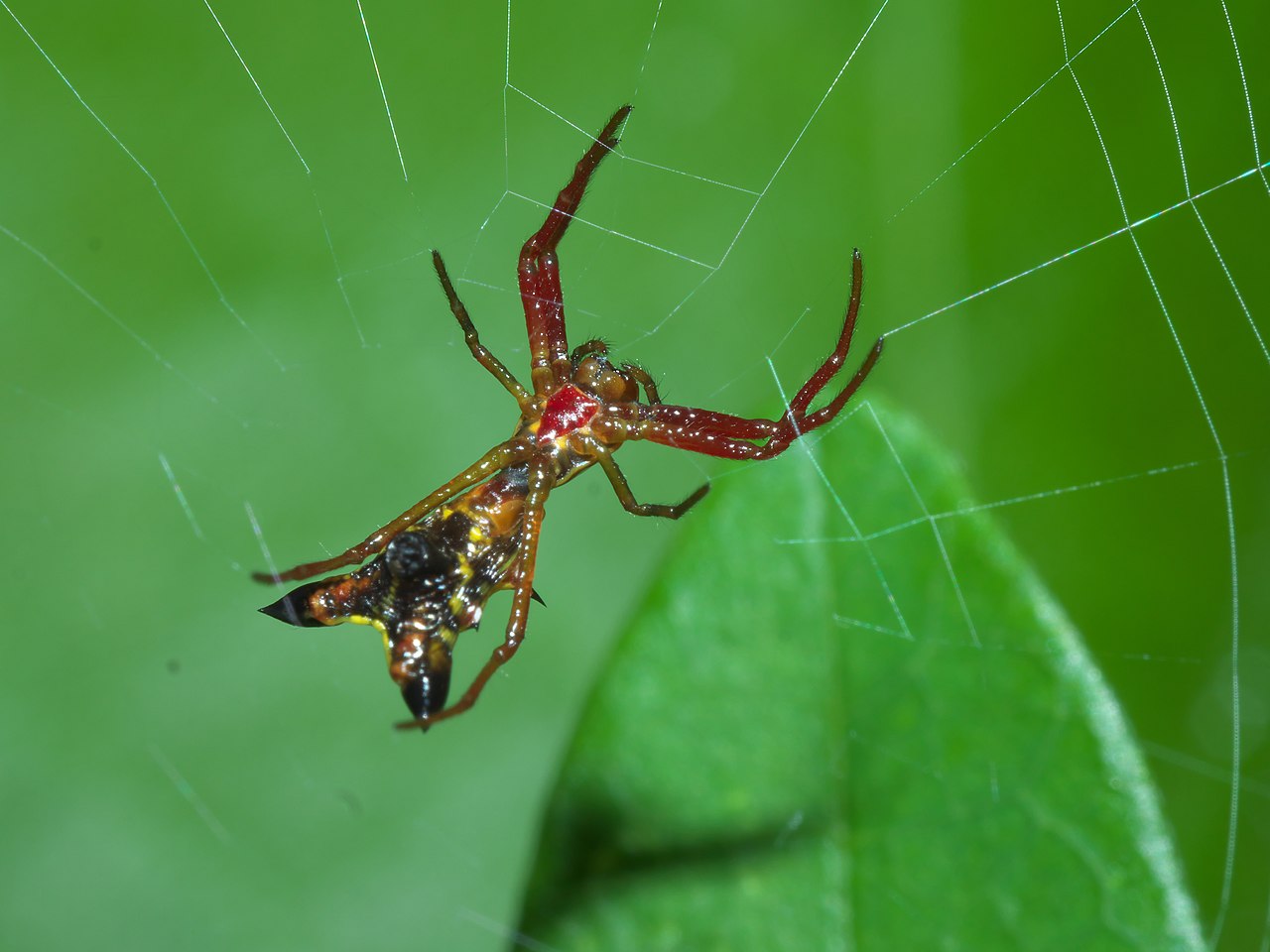
This species of spider (Micrathena sagittata) has an abdomen shaped like an arrow.
While its coloring may differ geographically, its dorsal abdomen is mostly yellow. The rest of the body is dark red or even black.
Its ventral abdomen is mostly red, with tiny yellow marks.
The species grows to 5mm and it can be seen building spider webs on different plants and shrubs.
25. Brown Recluse

Brown Recluse spiders (Loxosceles reclusa) have necrotic venom. This type of venom has no major impact on most humans, apart from the pain it causes.
Exceptions apply and skin necrosis might be one of the more severe reactions to the bite of the Brown Recluse. Medical attention must be immediate in the case of a bite.
The colors of these spiders can differ. It can appear almost white or almost fully brown. It grows up to a size of 20mm.
26. Dark Fishing Spider

Also brown, the Dark Fishing Spider (Dolomedes tenebrosus) is a species that lives next to water sources, sometimes feeding on small fish.
This species grows up to a size of 26mm and are distinguished by a brown color with black marks and black chevron-like patterns across its body.
The bites of the spider are rarely reported as they don’t lead to serious bad reactions.
27. Southern House Spider
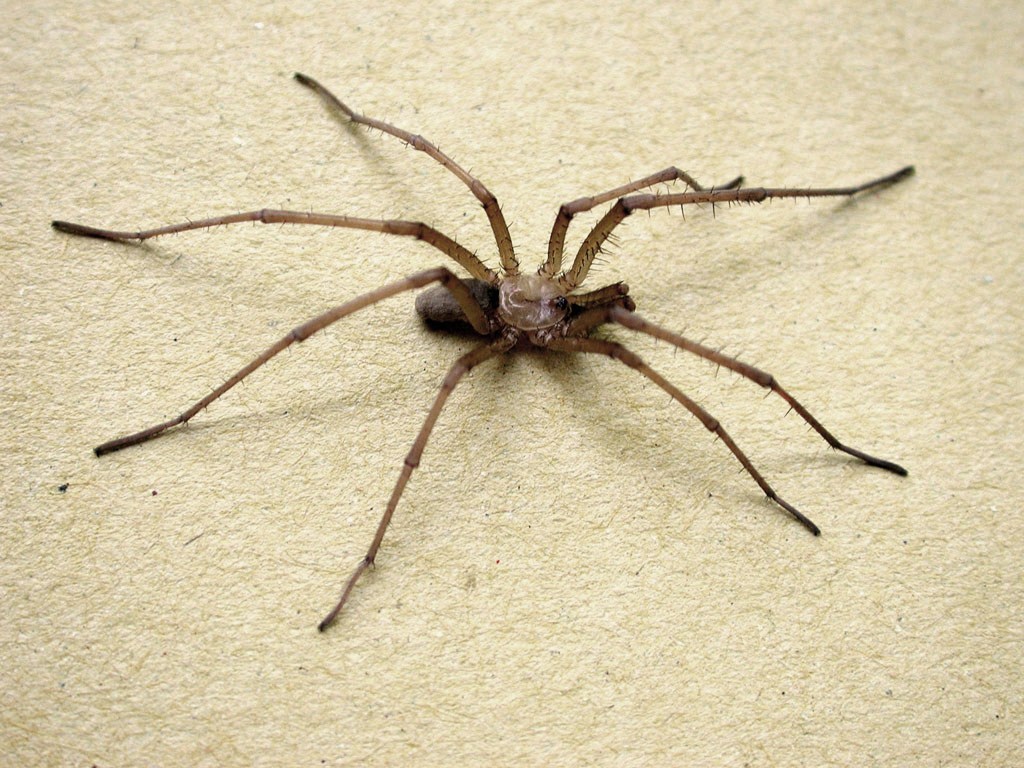
This species (Kukulcania hibernalis) looks highly similar to the Brown Recluse. However, it poses a reduced threat to humans as it’s not known to bite.
A common sight around homes, the Southern House Spider is mainly interested in insects attracted to lights around homes or in homes.
Growing up to 19mm, this species has a khaki or tan color.
It can be eliminated from homes with frequent vacuuming and by eliminating other insects and bites that lure it indoors.
28. Triangulate Combfoot

This type of spider (Steatoda triangulosa) has a dark brown color and bright triangular patterns on its bulbous abdomen.
Triangulate Combfoot spiders have a small size that measures anywhere between 3 and 6mm.
Multiple other spiders are often eaten by the small Triangulate Combfoot, including venomous species such as the Brown Recluse.
29. Bowl-and-doily Spider

A red-brown color is specific to this spider species (Frontinella pyramitela). It also shows contrasting white patterns across the abdomen.
Bowl-and-doily Spiders are among the smallest species in Alabama. They grow to a size of up to 4mm.
It builds a spider web which helps it traps all types of small insects such as gnats.
30. Red-femured Spotted Orbweaver

This species (Neoscona domiciliorum) is named after the red legs of the female spider.
Common in hardwood woodlands, this is a spider species that grows to 16mm in the case of females and up to 8mm in the case of males.
It builds small spider webs which may measure up to 20 inches in diameter.
These spiders are nocturnal and not easily spotted at night when found in suburban areas.
Females are very active at night when they repair their spider webs before sunrise.
These spider webs are rarely repaired in the fall, mainly due to lower energy levels based on scarce food supplies.